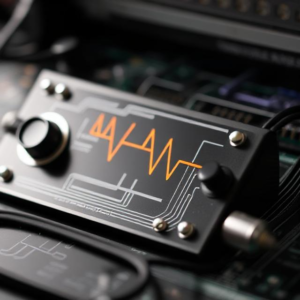What is an Amplifier?
An amplifier is a device that makes weak electrical signals stronger. For example, it can take a tiny sound signal from a microphone and make it strong enough to drive speakers.
However, when amplifying signals, we often need to control how the amplifier behaves. This is where feedback comes in.

What is Feedback in Amplifiers?
Feedback in an amplifier is when a portion of the output signal is sent back to the input. This feedback helps control and adjust how the amplifier behaves. It’s like adjusting the volume on your speaker to make sure the sound is just right!
Types of Feedback in Amplifiers
There are two main types of feedback used in amplifiers:
- Positive Feedback:
- Positive feedback means the output signal is fed back to the input in such a way that it increases the input signal. This can cause the amplifier to become more powerful, but it can also lead to instability or unwanted noise (this is often avoided in most amplifier designs).
- Negative Feedback:
- Negative feedback is more commonly used and means the output signal is fed back in such a way that it reduces the input signal. This helps to make the amplifier more stable, linear, and predictable. It also reduces distortion and improves the overall performance of the amplifier.
Negative Feedback in Amplifiers
Let’s focus on negative feedback because it’s widely used in amplifier circuits.
- How does it work?
- In an amplifier with negative feedback, part of the output is sent back to the input but in reverse polarity (inverted). This reverses the effect of the output signal and “cancels out” part of the input signal, leading to a cleaner and more controlled amplification.
- Think of it like having a friend help you read a loud and unclear sentence—your friend can correct you if you’re getting too loud, so your voice stays at a clear, steady level.
- Why is negative feedback useful?
- Stabilization: It makes the amplifier more stable, meaning it works consistently over a range of different conditions (like temperature and power supply variations).
- Reduces Distortion: It reduces unwanted noise and distortion in the amplified signal.
- Improves Bandwidth: It helps improve the amplifier’s ability to work over a wider range of frequencies (better sound quality for audio amplifiers, for example).
- Increases Linearity: The output signal will be a more accurate version of the input signal, without the amplifier introducing too much distortion.
How Feedback Affects the Amplifier’s Performance
- Gain Control: The amount of feedback determines how much the amplifier amplifies the signal (its gain). More feedback typically reduces the gain but improves the quality of amplification. Less feedback increases the gain but may cause distortion or instability.
- Impedance Control: Feedback can help control the input and output impedance of the amplifier, making it more compatible with various devices.
- Response to Signals: Feedback affects how the amplifier responds to different frequencies. With feedback, the amplifier is more likely to produce consistent sound quality across a wide range of frequencies.
Example of a Feedback Circuit
Here’s a basic example of how negative feedback might work in an amplifier:
- Op-Amp (Operational Amplifier): An op-amp is a popular type of amplifier that’s often used in feedback circuits.
- Basic Setup: In an op-amp, negative feedback might be used to make sure the output stays stable. A small part of the output is connected to the input through a resistor (this is the feedback loop).
- Action: If the output signal gets too high, the feedback signal reduces the input, causing the output to lower. This keeps the amplification controlled and prevents distortion.
Practical Applications of Feedback Circuits
- Audio Amplifiers: In audio systems, feedback circuits are used to ensure that sound is amplified cleanly without distortion, maintaining the quality of music or speech.
- Operational Amplifiers (Op-Amps): Op-amps in circuits use feedback to regulate voltage levels and improve the precision of measurements, making them essential in things like sensors, filters, and signal processing.
- Voltage Regulators: Feedback circuits are used in voltage regulators to ensure the output voltage remains constant, even if the input voltage fluctuates.
- Power Amplifiers: In power amplifiers, feedback is used to keep the output signal stable and prevent damage to the system, especially in high-power applications.
Key Points to Remember
- Feedback is when part of the output is sent back to the input.
- Negative feedback helps stabilize and control the amplifier, reducing distortion and improving performance.
- Positive feedback can increase gain but might cause instability, so it’s not commonly used in most amplifiers.
- Amplifier feedback circuits are used in many applications, from audio systems to precise measurement instruments.
In simple terms, feedback circuits make amplifiers more reliable, efficient, and clean by carefully controlling how the signal is processed. They’re like the “safety net” that ensures your amplifier works well, no matter what!
Tags: Amplifier, Amplifier Stability, Audio Amplifiers, Audio Systems, Bandwidth, Distortion Reduction, Electronics, feedback, Feedback Applications., Feedback Circuit, Feedback Loop, Frequency Response, Gain Adjustment, Gain Control, High-Power Applications, Impedance Control, Linearity, Negative Feedback, Noise reduction, Operational Amplifiers (Op-Amps), Positive Feedback, Power Amplifiers, Precision Measurements, Signal amplification, Signal Control, Signal Processing, Signal Quality, Signal Response, Stability, Voltage Regulators, Voltage Stability

